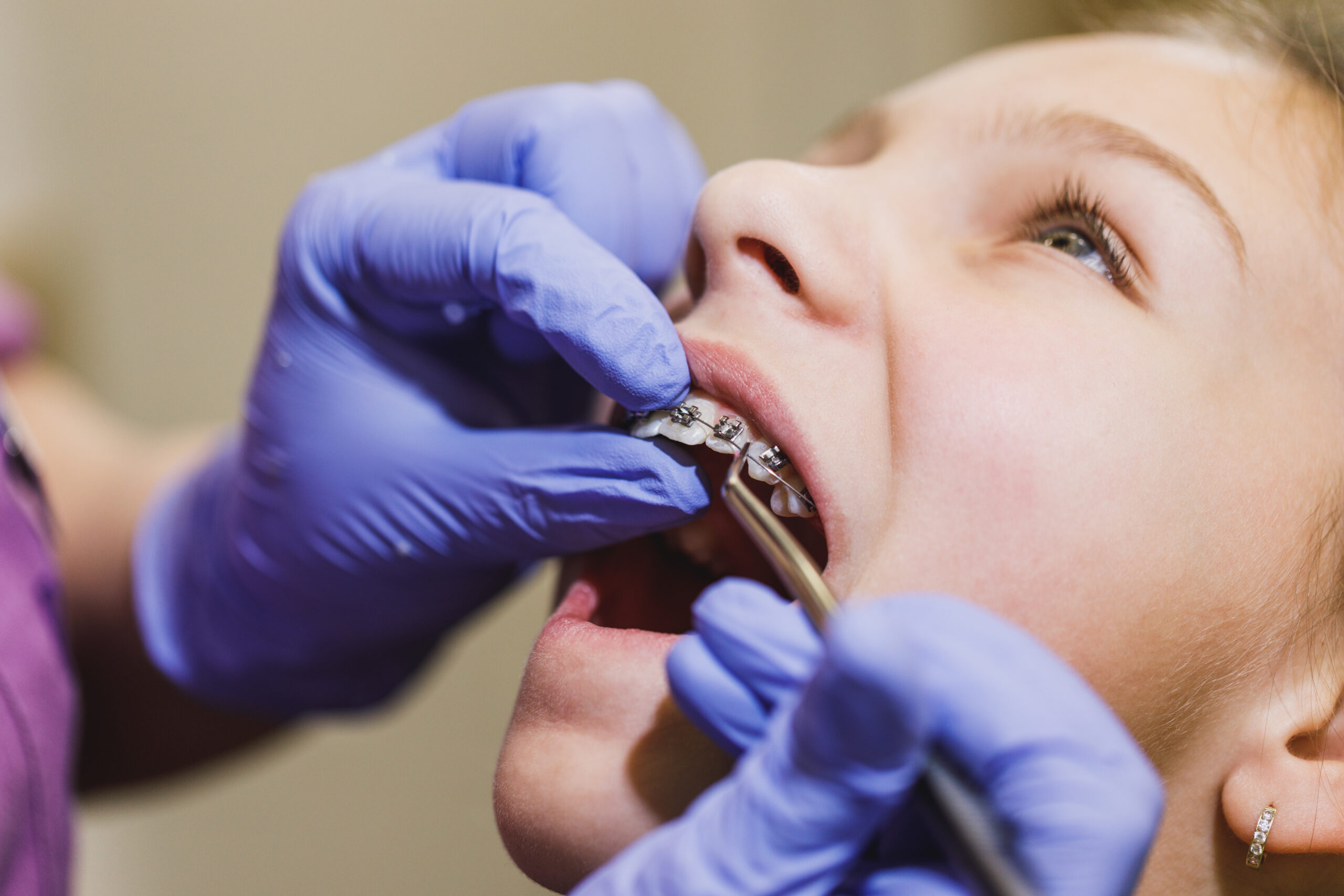
Some kids exhibit certain red flags that could negatively affect the growth and development of their jaws and teeth, and make orthodontic treatment more difficult as a teen or adult. Early orthodontic exams at age 7 are important, because I’m able to catch any abnormalities and ensure we don’t miss the window of opportunity where growth corrections can be made.
If your child needs two-phase orthodontic treatment, you’ll be happy to know that the approach has major benefits.
In this post, I’ll be covering what exactly two-phase treatment is, when it’s necessary, and what the advantages are.
What is Two-Phase Orthodontic Treatment?
The American Association of Orthodontists recommends kids have their first orthodontic evaluation by age 7. Because the first permanent molars are in at this point, the orthodontist can get a good idea of how their bite, jaw and facial development, teeth eruption and development are stacking up.
While most kids won’t need treatment right away, for some kids, two-phase orthodontic treatment will achieve the best results. As the name suggests, it entails completing treatment in two separate phases.
At Jeffrey Kwong Orthodontics, my team and I treat kids conservatively and only recommend this approach when there are clear health or functional benefits and/or it wouldn’t be possible to achieve the same results later in life.
When two phases of orthodontic treatment are necessary, it typically looks something like this:
Phase 1 Orthodontic Treatment
Phase 1 orthodontic treatment, also called early interceptive orthodontic treatment, begins during a child’s mixed dentition phase (when they have both baby teeth and permanent teeth). For most kids, this means starting treatment sometime between the ages of 7 and 10. My goal is to finish phase 1 treatment in about one year.
The objective of this first phase is to develop the jaw size so the upper and lower jaws relate to each other and the permanent teeth will have enough room to fit. For this reason, early orthodontics doesn’t necessarily mean braces for kids.
Even when phase 1 braces are used, they’re limited to a few teeth and are meant to achieve very specific goals. Usually, other types of orthodontic appliances are used instead, such as palatal expanders, to guide jaw growth and change the foundation of the bite to help us develop a broad smile with more space for the teeth.
Take a Break
When we achieve the goal of phase 1, there’s a resting period. I remove the appliance and, depending on the situation, the child may or may not wear a retainer to prevent any movement.
During this breather, we allow the remainder of the permanent teeth to erupt. The child will come in for routine growth and development checkups so I can monitor them. Then, when the time is right, they’ll start phase 2 treatment.
Phase 2 Orthodontic Treatment
Phase 2 orthodontic treatment involves wearing braces, InBrace®, or Invisalign® Teen to straighten the permanent teeth and finetune the bite. This phase starts when the majority, or all, of the permanent teeth are in, between ages 11 and 14, depending on gender and your child’s specific growth and stature. When teens finish treatment, they’ll wear a custom retainer to hold their teeth in place and ensure the results last a lifetime.
When is Two-Phase Orthodontic Treatment Needed?
While phase 1 focuses on making room and/or correcting skeletal abnormalities, phase 2 focuses on straightening the permanent teeth and creating a healthy, stable bite. So patients who undergo early orthodontic treatment will require a second phase of treatment with metal braces, clear braces, InBrace, or clear aligners.
Depending on the case and the severity of the issue, early interceptive orthodontic treatment could be indicated if a child has:
- A discrepancy between the size of the upper and lower jaw that will lead to an issue like a significant overbite or underbite
- An emerging crossbite (upside down bite) that may cause skeletal changes
- Severe crowding
- Protruding front teeth that are likely to get damaged
- An open bite that interferes with eating and speaking
- Problems with the pattern or timing of teeth eruption
- Oral habits like tongue thrust or prolonged thumb sucking or pacifier use that create improper bite relationships for front teeth and the jaws.
Again, every child is unique and the problems on this list won’t always need two phases of treatment.
What are the Advantages of
Two Phases of Orthodontic Treatment?
When a child needs two-phase orthodontic treatment, it can have major benefits including:
1.Preventing or correcting issues before they become bigger problems
Early orthodontic treatment is a way to intercept emerging issues before they evolve into major concerns.
For example, let’s say your child’s upper jaw is underdeveloped and they’ll experience severe crowding when their permanent teeth erupt. Expanding the jaw with a rapid palatal expander during the first phase of treatment will create enough room to accommodate the teeth, either minimizing or preventing crowded or impacted teeth altogether.
2.Making Invisalign Teen, InBrace, or braces faster and easier
Phase 1 treatment creates the optimal conditions for permanent teeth eruption, so phase 2 orthodontic treatment is easier and quicker than it would have been. I don’t have to spend nearly as much time on staging and sequencing and complicated tooth movements, because I’ve already established a good foundation.
For certain bite problems, just the act of breaking up treatment and completing it over time makes each individual phase less intense. Think of it like studying for a test an hour a night over the course of two weeks versus cramming all of your studying into one night.
3.Avoiding the need for invasive treatments like surgery or extractions
Once the permanent teeth have erupted, there are instances where teeth have to be extracted because of the severity of crowding or issues like impaction. As for bite problems, such as a significant overbite or underbite, when the jaw and facial bones are done growing, corrective jaw surgery may be the only way to get an optimal outcome.
Another of the biggest benefits of two-phase orthodontic treatment is that it may help kids avoid the need for these types of invasive procedures. Since treatment starts before the permanent teeth are all in and a child is in a period of rapid growth, I can use non-invasive methods to achieve more space in the arches and manipulate the jawbones.
4.Saving money in the long run
If your child needs phase 1 braces or an appliance, it probably feels like you’re paying more upfront, especially since you may not have anticipated investing in orthodontics until their teen years. The good news is that in many cases, you will actually save money.
Your child’s phase 2 orthodontic treatment will likely be faster and more straightforward. Two phases of treatment is much more affordable than corrective jaw surgery and, since your child will have fewer complications down the line, you won’t have to spend money on additional treatments and correction.
5.Achieving awesome results
When I recommend two-phase orthodontic treatment, it’s because I know that it will give a child an outcome that may not be possible later. The combination of orthopedic correction and orthodontic treatment maximizes the opportunity to accomplish healthy, functional, aesthetic results that will remain stable throughout the patient’s lifetime.
6.Improving function
Some malocclusions, including a severe open bite, crossbite, or underbite, make biting and chewing difficult. When the issue interferes with your child’s ability to eat and/or comfortably open and close their jaw, the benefits of early orthodontics far outweigh the cost. Treatment will improve function and comfort and can even help with things like speech development.
7.Improving oral and overall health
Getting an 8- or 9-year-old to brush and floss their teeth properly can be challenging at the best of times. Throw in crowding and jaw misalignment and it becomes even more arduous. Two phases of orthodontic treatment can help align the teeth and jaws, making brushing and flossing easier and more effective, which results in better oral health.
Beyond that, jaw abnormalities can sometimes contribute to mouth breathing, snoring, and sleep-disordered breathing. These, in turn, interfere with a child’s overall health and development.
The benefit of an early consultation is that we can help screen for these types of problems and help you advocate for further medical evaluation as necessary. While orthodontic treatment, such as maxillary expansion, can’t guarantee improved breathing in every case, there are times it’s helpful, particularly as part of a larger, holistic treatment plan that looks at all causes of airway obstruction.
8.Boosting confidence
Last, but certainly not least, two-phase orthodontic treatment can have a huge impact on a kid’s confidence and self-esteem that carries over into all areas of their life. You’ll probably notice positive changes even after the first phase of treatment.
Orthodontics for Kids in El Dorado Hills, CA
Book your child’s complimentary growth and development checkup at Jeffrey Kwong Orthodontics. As mentioned earlier, the American Association of Orthodontists recommends that a child be seen for a consultation by age 7 – no referral is necessary.
Whether your child needs two-phase orthodontic treatment or not, my team and I will make the experience educational and fun. I’ll also be able to pinpoint the ideal time for them to start treatment in order to achieve exceptional, lifelong results.

